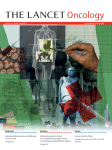Lancet Oncol:不推荐根治性放化疗合并西妥昔单抗治疗食管癌
2013-05-06 Lancet Oncol MedSci原创
对于食管癌患者而言,根治性放化疗是手术治疗的另一个替代治疗方案,同样可以达到治愈疾病的目的。SCOPE1研究旨在调查在局灶性食管鳞状细胞癌患者和腺癌患者中,在以顺铂和氟嘧啶为基础的根治性放化疗方案上联合西妥昔单抗后对上述患者治疗的有效性、安全性和治疗可行性情况。来自英国Velindre医院的Thomas Crosby等为了试图找到上述问题的答案而设计了相关研究,并将其研究结果发表在Lancet O
对于食管癌患者而言,根治性放化疗是手术治疗的另一个替代治疗方案,同样可以达到治愈疾病的目的。SCOPE1研究旨在调查在局灶性食管鳞状细胞癌患者和腺癌患者中,在以顺铂和氟嘧啶为基础的根治性放化疗方案上联合西妥昔单抗后对上述患者治疗的有效性、安全性和治疗可行性情况。来自英国Velindre医院的Thomas Crosby等为了试图找到上述问题的答案而设计了相关研究,并将其研究结果发表在Lancet Oncol 4月的在线期刊上。
本研究为多中心、随机、开放式标签、2/3期临床研究,本研究所纳入的受试者为年龄在18岁及以上、经组织学确诊的非转移性食管癌(腺癌、鳞状细胞癌或未分化癌,疾病分期I-III,WHO一般状态分级0-1),这些受试者来自于英国放疗中心,并且他们适合进行根治性放化疗。研究者将符合上述入组标准的受试者按照1:1比例随机分为2组,其中一组受试者仅接受根治性放化疗,另一组受试者在根治性放化疗的基础上联合西妥昔单抗治疗。西妥昔单抗的治疗方案为:第一天400mg/m2,继之以250mg/m2的剂量每周应用一次。在本研究中,研究者根据受试者入组的医院、不接受手术治疗的主要原因、肿瘤组织学特征和肿瘤分期对受试者进行分层。在本研究中应用的放化疗方案如下,第一天:顺铂60mg/m2,第1-21天:卡培他滨625mg/m2,共4个疗程。在进行第3和第4个疗程治疗时,受试者同步接受总剂量为50Gy的放疗(分25次进行)。对2期研究而言,本研究的主要终点事件是在治疗后第24周时未出现治疗失败的受试者所占的比例;而对于3期研究而言,主要终点事件为受试者的总体生存期。研究者采用意向治疗分析法对研究结果进行分析。本研究为国际标准随机对照研究,注册号为47718479。
共有258名受试者被纳入研究中,两组的受试者分为129人,这些受试者来自于英国的36个研究分中心,受试者入组时间为2008年2月7日至2012年2月22日。在进行3期临床研究时,由于研究达到了无效的标准,研究者停止了对受试者的入组,但是研究者仍继续对入组的受试者进行随访直至达到随访时间至少为24周(对于存活的受试者的中位随访时间为16.8月,IQR 11.2-24.5)。与仅接受放化疗的受试者(121人中有93人)相比,放化疗联合西妥昔单抗组的受试者(119人中有79人)在第24周时治疗没有出现失败的受试者数更少,两组比例分别为76.9%和66.4%。此外,放化疗联合西妥昔单抗组的受试者的中位总体生存期也更短,为22.1月(95%可信区间为15.1-24.5),而放化疗组的受试者的中位总体生存期为25.4月(95%可信区间为20.5-37.9),两组差异具有显著统计学意义。研究者发现,在放化疗联合西妥昔单抗组的受试者出现非血液系统3级或4级不良反应事件的人数更多,两组分别为102人(79%)和81人(63%),差异同样具有显著统计学意义。最常见的3级或4级不良反应事件为白细胞计数降低(放化疗联合西妥昔单抗组/放化疗组:12%/19%)、中性粒细胞绝对值降低(放化疗联合西妥昔单抗组/放化疗组:11%/16%)、疲劳(放化疗联合西妥昔单抗组/放化疗组:20%/19%)和吞咽困难(放化疗联合西妥昔单抗组/放化疗组:27%/29%)。
本研究结果指出,在适合进行根治性放化疗的食管癌患者中,并不推荐在标准放化疗方案的基础上联合应用西妥昔单抗。
与食管癌相关的拓展阅读:
- ASO:cT1-T2/cN0期食管癌患者可进行前哨淋巴结探查
- ASO:cT1-T2/ cN0期食管癌患者可进行前哨淋巴结探查
- Ann. Surg:抗反流手术后复发增加食管癌风险
- Am J Gastroenterol:内镜切除术后食管癌转移率长期风险与浸润深度相关
- ASO:p53与食管癌化疗缓解率相关
- Radiother Oncol:N1小细胞食管癌治疗首选放化疗 更多信息请点击:有关食管癌更多资讯

Chemoradiotherapy with or without cetuximab in patients with oesophageal cancer (SCOPE1): a multicentre, phase 2/3 randomised trial
Background
Definitive chemoradiotherapy (CRT) is an alternative to surgery for the curative treatment of oesophageal carcinoma. The SCOPE1 trial aimed to investigate the addition of cetuximab to cisplatin and fluoropyrimidine-based definitive CRT in patients with localised oesophageal squamous-cell cancer and adenocarcinomas to assess activity, safety, and feasibility of use.
Methods
In this multicentre, randomised, open-label, phase 2/3 trial, we recruited patients aged 18 years and older from UK radiotherapy centres who had non-metastatic, histologically confirmed carcinoma of the oesophagus (adenocarcinoma, squamous-cell, or undifferentiated; WHO status 0—1; stage I—III disease) and been selected to receive definitive CRT. Patients were randomly assigned (1:1) via a central computerised system using stratified minimisation (with an 80:20 random element) to receive CRT alone or CRT with cetuximab (400 mg/m2 on day 1 followed by 250 mg/m2 weekly), stratified by recruiting hospital, primary reason for not having surgery, tumour histology, and tumour stage. CRT consisted of cisplatin 60 mg/m2 (day 1) and capecitabine 625 mg/m2 twice daily (days 1—21) for four cycles; cycles three and four were given concurrently with 50 Gy in 25 fractions of radiotherapy. The primary endpoint was the proportion of patients who were treatment failure free at week 24 for the phase 2 trial and overall survival for the phase 3 trial, both measured from randomisation. We analysed data by intention to treat. This trial is an International Standard Randomised Controlled Trial, number 47718479.
Findings
258 patients (129 assigned to each treatment group) from 36 UK centres were recruited between Feb 7, 2008, and Feb 22, 2012. Recruitment was stopped without continuation to phase 3 because the trial met criteria for futility, but we continued to follow-up recruited patients until all had reached at least 24-week follow-up (median follow-up of patients who survived was 16·8 months [IQR 11·2—24·5]). Fewer patients were treatment failure free at 24 weeks in the CRT plus cetuximab group (79 of 119 patients [66·4%, 90% CI 58·6—73·6]) than in the CRT only group (93 of 121 patients [76·9%, 69·7—83·0]). The CRT plus cetuximab group also had shorter median overall survival (22·1 months [95% CI 15·1—24·5] vs 25·4 months [20·5—37·9]; adjusted HR 1·53 [95% CI 1·03—2·27]; p=0·035). Patients who received CRT plus cetuximab had more non-haematological grade 3 or 4 toxicities (102 [79%] of 129 patients vs 81 [63%] of 129 patients; p=0·004). The most common grade 3 or 4 toxicities were low white blood cell count (14 [11%] in the CRT plus cetuximab group vs 21 [16%] in the CRT only group), low absolute neutrophil count (15 [12%] vs 24 [19%]), fatigue (26 [20%] vs 25 [19%]), and dysphagia (35 [27%] vs 37 [29%]).
Interpretation
The addition of cetuximab to standard chemotherapy and radiotherapy cannot be recommended for patients with oesophageal cancer suitable for definitive CRT.
Funding
Cancer Research UK.
本网站所有内容来源注明为“梅斯医学”或“MedSci原创”的文字、图片和音视频资料,版权均属于梅斯医学所有。非经授权,任何媒体、网站或个人不得转载,授权转载时须注明来源为“梅斯医学”。其它来源的文章系转载文章,或“梅斯号”自媒体发布的文章,仅系出于传递更多信息之目的,本站仅负责审核内容合规,其内容不代表本站立场,本站不负责内容的准确性和版权。如果存在侵权、或不希望被转载的媒体或个人可与我们联系,我们将立即进行删除处理。
在此留言








#西妥昔#
74
#Oncol#
55
#Lancet#
66
#放化疗#
61
#食管#
58
#根治#
66